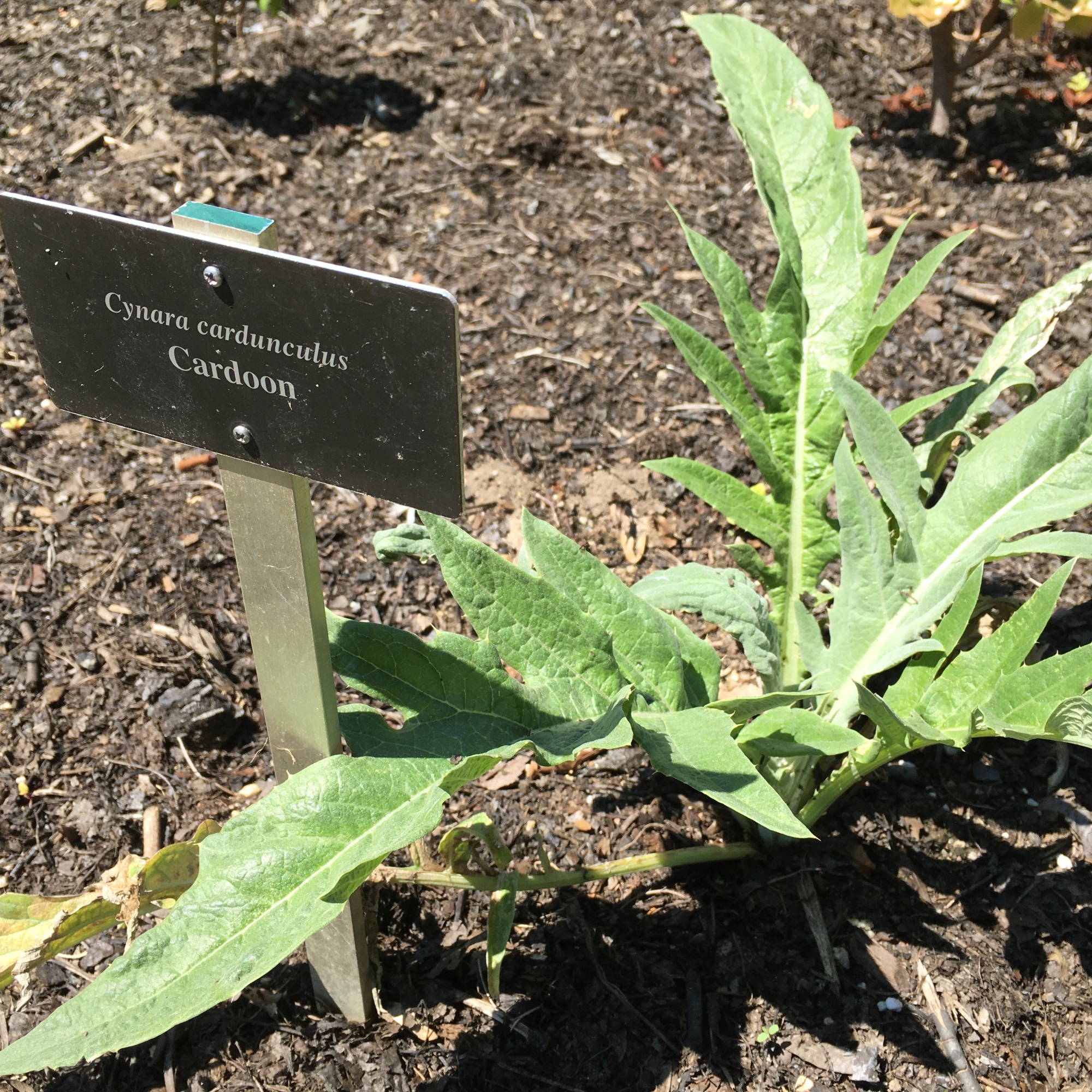
The cardoon, Cynara cardunculus, is one of my favorite plants at Green Spring Gardens. The species name, cardunculus, means “resembling a small thistle,” and if you look closely you can see that it does resemble a thistle. Cardoon is a tender perennial hardy in zones 7-9; Northern Virginia is in zone 7. It can grow to heights of five to seven feet, often towering over other plants and making a bold statement in the summer months. Next to the front door of the Historic House at Green Spring Gardens, the cardoon’s deeply cut silver-gray leaves stand out among the medium and fine textured leaves of the plants surrounding it.
The cardoon has a rich and interesting history, both as an edible and an ornamental plant. It is native to the Mediterranean and was popular in ancient Greek, Roman, and Persian cuisine. It was brought by Spanish settlers to California in the mid-1800s, also by French settlers to the Louisiana Territory, and was grown in colonial gardens.

Cardoon is easy to grow from seed, and you can also propagate it from divisions or root cuttings. The plants can have spines, so you will want to wear gloves when you handle them. There are several varieties that vary somewhat in color. To grow cardoon, plant the seeds or cuttings in full sun and in moist but well-drained fertile soil. It also does best when protected from strong winds. When I have grown cardoon, they sometimes do not survive the winter—perhaps because my soil does not drain well enough and the roots stay too wet. For colder areas, mulching the plant after cutting it back and then covering it with a bucket and then a tarp may help.
In its first year, the cardoon will grow into a large, urn-shaped plant. If started early enough, it may bloom the first year but, like most perennials, it will likely bloom the second year. I personally love how cardoons look before the stalks lengthen as the buds grow and bloom. At this pre-bloom stage, usually late May to early June, the plant is especially striking and becomes a dramatic architectural focal point in the garden with its large silver leaves. When it blooms in late June, it becomes attractive in a different way, with its beautiful purple, thistle-like flowers.
In some areas of California, where it has escaped the confines of host gardens, it is considered an invasive weed. In Northern Virginia, as illustrated by the beautiful specimens at Green Spring Gardens, it is becoming more popular as an ornamental, with its commanding presence and its vivid purple flowers, which are also supposed to be excellent for cutting and drying.


The largest and most impressive cardoons at Green Spring Gardens are the ones at either side of the Edible Garden, which is appropriate since cardoon plants are edible. This plant is closely related to the globe artichoke and is still cultivated for food in southern Europe and northwest Africa. The stalks are described as artichoke-flavored, and the bud is edible, though it is considered a poor substitute for the globe artichoke’s fleshy bud. Suggested cooking techniques include binding the stalks with newspaper or burlap to blanch them or parboiling and rinsing them to reduce bitterness. I have never eaten them, but I found a 2015 New York Times article and recipe by Mark Bittman for butter-braised cardoon with mushrooms and breadcrumbs that sounded delicious and made me want to try them if I ever have enough plants.

Cardoon is a bold and versatile plant as a stand-alone accent or as a part of your edible landscape. Whether you eat it or not, it adds visual interest and attracts bees. It would also be a great addition to a mixed border next to white flowers and other silver-leafed plants like dusty miller, artemisia, or lamb’s ears. It pairs well with blue or red flowers and bronze foliage.
Visit Green Spring Gardens and see this wonderful plant for yourself. You will no doubt be inspired to have one in your garden, and Green Spring Master Gardeners and staff will be happy to provide additional guidance.
Author Carla Roeper is a Green Spring Gardens Extension Master Gardener. Learn more about the cardoon from Carla in her video on YouTube.
